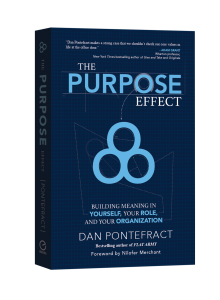Dan Pontefract's Blog, page 27
September 17, 2016
Has Wells Fargo’s CEO Forgotten How To Lead?
 Photographer: Kimberly White/Bloomberg News
Photographer: Kimberly White/Bloomberg NewsThere were audible gasps. Incredulous looks of dismay. Bemused shrieks.
Whether you are a customer, employee, shareholder or partner of Wells Fargo, no doubt your perception of the bank has suddenly taken a nose dive.
Ever since Wells Fargo was levied a $185 million fine by the Consumer Financial Protection Bureau (CFPB) for fraudulent employee behaviours of epic proportions—first reported by the LA Times in 2013—there has been an avalanche of opinion and outrage. According to the CFPB, employees of Wells Fargo “secretly opened accounts and shifted funds from consumers’ existing accounts into these new accounts without their knowledge or permission to do so, often racking up fees or other charges.”
I’m no banker, but this isn’t good.
The bank has terminated over 5,000 employees as a result of the fiasco, over a five-year period.
Furthermore, shareholders are now pushing the bank to investigate “whether the divestiture of all non-core banking business segments would enhance shareholder value, and whether it should divide into a number of independent firms.”
That is going to tie people up in senior roles at Wells Fargo for months.
But what this comes down to—as it always does in the aftermath of a PR disaster like with the Wells Fargo story—is an indictment on corporate culture and leadership practices.
Or in the case of Wells Fargo, a culture that exhibits disdain for employees and leadership practices that encourage power, competition and the setting of impossible performance targets.
Just this week in an interview with the Wall Street Journal, Wells Fargo CEO, John Stumpf, seemed to lay blame specifically on rogue employees, not the organization itself. Stumpf slyly suggested that the 5,300 employees that were terminated as a result of the scandal failed to put customers first or honour the vision and values of the bank.
“If they’re not going to do the thing that we ask them to do — put customers first, honor our vision and values — I don’t want them here,” Stumpf acknowledged. “I really don’t.”
Not once did Stumpf insinuate that there was a corporate culture issue at Wells Fargo. Not once did he or his C-Suite take responsibility for the unethical behaviours.
“Nothing to see here,” he might as well have added. “Just a few scallywag employees caught up doing the wrong thing at the wrong time.”
Senator Elizabeth Warren is right to demand that Stumpf “be held accountable for this [situation], as does the rest of his senior management.”
But so far, nothing is happening to senior leaders. So far, the culture seems to be staying the same at the bank. (aside from 5300 less employees) Michael Corkery of the New York Times, for example, wrote a ”bank spokeswoman declined to say whether any senior executives had been reprimanded or fired in the scandal.”
Ultimately, Stumpf is creating a competitive disadvantage for Wells Fargo. If you are a current customer of the bank, does it not make you think “why” you’re still with it? If you’re out there shopping for a new bank, does Wells Fargo shoot to the top of the list, now that you’ve discovered there may be unethical practices going on at the company?
In his book The Future of Work, Tom Malone states:
“As managers, we need to shift our thinking from command and control to coordinate and cultivate — the best way to gain power is sometimes to give it away.”
There is no doubt in my mind that there were (or perhaps are) hundreds and hundreds of managers, directors and vice-presidents—the chain of command—at Wells Fargo that cultivated a ‘command and control’ leadership style, pushing the now exited employees to behave unethically. The culture at Wells Fargo would not seem to be one that fosters a ‘coordinate and cultivate’ mantra. Otherwise, this debacle would never have occurred in the first place.
In my research and work, I have found that there is a causal relationship, a deep link between the way in which we are leading our organizations and how employees behave.
We need to recognize that yesterday’s way of leading needs to be improved but it will not happen unless we look at leadership in a way that incorporates more open concepts as well as the inclusion of people’s opinion and ideas. Today, many companies have leadership development programs. But, do those companies have an actual leadership philosophy that speaks to everyone in the organization, in a society that is shifting towards “cultivate and coordinate” and away from “command and control”?
The meetings will be endless at Wells Fargo going forward. The Senate hearings are one thing … but just imagine how much more effort is now going to have to be paid to developing a culture that does indeed put its “customers first,” one that can also be considered a competitive advantage.
Right now, its culture is a disadvantage. For that, I feel for its employees, customers and other stakeholders.
But if Stumpf continues to believe that the corporate culture of Wells Fargo wasn’t the root cause of various employees opening 2 million fraudulent bank accounts—unbeknownst to its customers—in order for them to increase sales, commissions and bonuses, he is as incompetent as a leader as I am a banker.
If he does not take responsibility for the state of its culture—committing to improving it in the short and long-term—there is no doubt in my mind, employee engagement will tank, customer satisfaction will continue to wane, and its financial results will suffer greatly.
It’s avoidable. It’s preventable. But any CEO must make culture its competitive advantage if it wants to do so.
UPDATE: I’ve had five former Wells Fargo employees email me. Each of them a) thanked me for the article and b) confirmed that the culture was in fact as I have described above.
PS. Read more in my latest book, The Purpose Effect: Building Meaning in Yourself, Your Role and Your Organization
Download Chapter 1 … for free!
Audible version now available, too. (I’m the narrator!)
Dan's Related Posts:Give Piece a ChanceCase Study: Tim Hockey, a Collaborative & Transparent CEOCan Employee Engagement Improve Customer Satisfaction?I Am A Corporate FloaterDear C-Suite: We Don’t Do Training Anymore
September 16, 2016
Coming September 27, An Addendum to The Purpose Effect
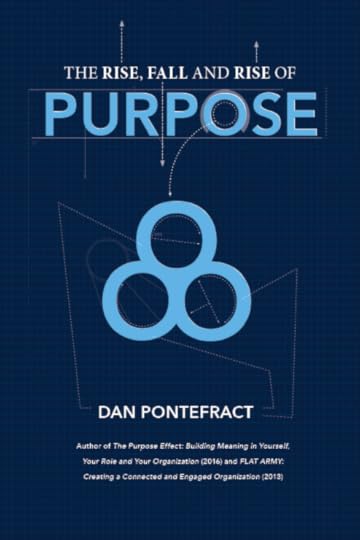 The Rise, Fall and Rise of Purpose by Dan Pontefract
The Rise, Fall and Rise of Purpose by Dan PontefractNot everything can fit into a book.
On September 27, 2016, I am releasing an addendum to my latest book, The Purpose Effect called “The Rise, Fall and Rise of Purpose.”
The description is as follows:
Workplace disengagement plagues many organizations across the globe, frequently leading to low productivity and workplace morale. This issue edges on epidemic status, with less than one-third of employees in the U.S. having reported a sense of engagement at work. Similarly, only 28 percent of employees feel as though their role at work gives them a sense of purpose. Organizations that find and implement solutions to these problems, however, create a major competitive advantage while simultaneously improving the quality of life for employees.
In this supplement to his latest book, The Purpose Effect, Dan Pontefract metaphorically examines the city of Detroit as both an example of the decline of purpose in the workplace and its potential to rebound and mend. There is hope for even the most disengaged organization, but only if the individuals who make up its culture are willing to find answers within themselves, dedicating their efforts to make a positive change.
You can order it as an eBook via the regular channels including Amazon, Chapters-Indigo, Barnes & Noble, and Kobo.
Dan's Related Posts:Lo-Tech Talk #3: Organizational PurposeThe Purpose Effect Book EndorsersLo-Tech Talk #1: Introduction to Personal PurposeLo-Tech Talk #2: The Leaders Guide to The Purpose EffectLo-Tech Talk #4: The Sweet Spot of Purpose
September 8, 2016
A Look Inside Letterman’s Staff Redefining Their Purpose After The Show Ended
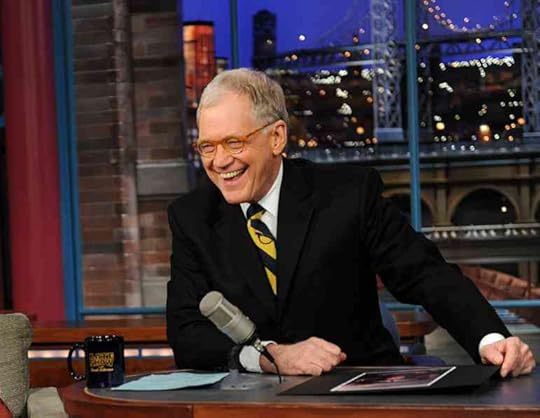 If you were a fan of David Letterman and his late night talk show you could easily identify on-camera characters like Paul Schaeffer, Biff Henderson and even Alan Kalter.
If you were a fan of David Letterman and his late night talk show you could easily identify on-camera characters like Paul Schaeffer, Biff Henderson and even Alan Kalter.
But what about all of the people behind the camera? The ones who produced, directed and wrote the show.
And whatever happened to them on May 26, 2015 … the day after Letterman’s last show aired on CBS?
A wonderful behind-the-scenes documentary has recently surfaced answering that very question.
The following behind-the-scenes employees at Late Show with David Letterman share wonderful insights, tidbits and anecdotes regarding the very last episode that aired May 25, 2015.
Executive Producer Rob Burnett
Director Jerry Foley
Writer Bill Scheft
Supervising Producer Kathy Mavrikakis
Writer Joe Grossman
Writer Steve Young
Supervising Producer Brian Teta
Executive Producer Barbara Gaines
Their comments are the premise of the first video (Part I) found below.
But what is far more interesting to me, is Part II.
Walter Kim–Senior Video Writer/Producer at LinkedIn who put the documentary videos together, but who also spent over 20 years in New York working with Letterman as his digital creative director–has provided a bit of The Purpose Effect gold.
In The Purpose Effect, I argue that individuals ought to be constantly defining and redefining their personal purpose if they are to remain in the sweet spot, both at work and in life. From the book:
Individuals who steadily define (and redefine) what they are in life and at work seize the opportunity for clarity. Determining and adjusting their disposition, character, identity, attributes and qualities ensures they offer themselves the chance to continually reach new levels of success.
Team members who successfully define, answer the question: Who am I in life and at work?
What Mr. Kim surfaces in Part II are the real-world struggles, trials and tribulations that these Letterman employees went through as that final show concluded. There are incredible stories and insights into their personal sense of purpose, and what was (and wasn’t) working for them during the lead up to that final show, as well as afterwards.
It’s rare to get such raw and truthful feedback from people who spent so many years in a family unit, working in roles that they clearly loved. For some, their personal purpose was questioned. For others, it gave them a chance to redefine who they wanted to be post-Letterman.
These are not rich celebrities either. Just normal folk, looking for a way to remain in the ‘sweet spot,’ something each of them were clearly in during their respective tenures at Late Show.
Enjoy.
Part I
Part II
PS. Read more in my latest book, The Purpose Effect: Building Meaning in Yourself, Your Role and Your Organization
Download Chapter 1 … for free!
Audible version now available, too. (I’m the narrator!)
Dan's Related Posts:The Critical Importance Of Defining Your PurposeLeadership Lessons From Late Night King David LettermanFree Download of Chapter 1 – The Purpose Effect Download Chapter 1 of “The Purpose Effect” For FreeLo-Tech Talk #4: The Sweet Spot of Purpose
September 5, 2016
My Long Weekend Of Hope And Inspiration
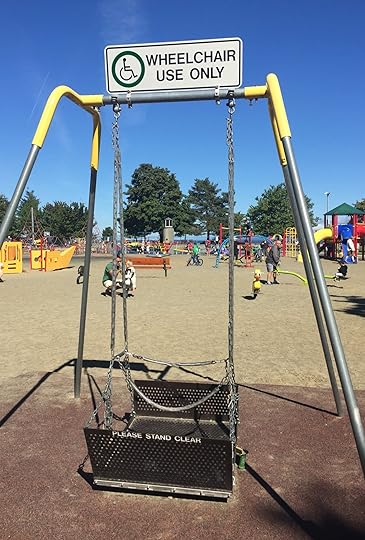 It started in Parksville, British Columbia. It was the beginning of a very hopeful and inspirational few hours.
It started in Parksville, British Columbia. It was the beginning of a very hopeful and inspirational few hours.
As the eldest and youngest of my three children were frolicking in a park near the eye-catching waters of Parksville Beach, my eye wandered toward the opposite corner.
“What’s that?” I wondered to myself. This rather large, metallic structure looked nothing like anything I had witnessed before in a public children’s park.
Sure enough, it was unique.
The picture you see to the right is a wheelchair swing. It was the first time I had ever seen such a contraption.
I immediately yelled to the girls. “Claire, Cate … come here and see this.”
We had a chat about equal rights and equality in general. Cate, nine-years old, reminded me that the Paralympics in Brazil were about to start on Wednesday. “So of course there should be a swing for disabled people,” she said to me nonchalantly. I was struck by both Claire and Cate’s attitude. They viewed this park as one, not one divided.
How hopeful. How inspirational.
We moved on to a local coffee shop called Pacific Brimm for some smoothies.
As I waited for the smoothies to be made–while the girls were keeping themselves occupied at a table–I flipped through my phone.
 There was an update on Facebook from a friend of mine. A screenshot of that update is found to the right.
There was an update on Facebook from a friend of mine. A screenshot of that update is found to the right.
McDonald’s is a for-profit company. Margins are razor-thin. I have never been to the McDonald’s in Stittsville, Ontario, but Perry and Jo-Ann McKenna–the owners of the restaurant–ought to be proud of the type of culture they have created.
As you can read from the update, a moment of duress turned into a moment of hope, and of inspiration.
After the smoothies, we headed to Coombs, a short 10-minute drive up the highway from Parksville.
We have made the journey in the past. What’s not to love about visiting The Old Country Market, where there are literally goats on the roof. (And they weren’t my children.)
But it’s not the goats that impressed me.
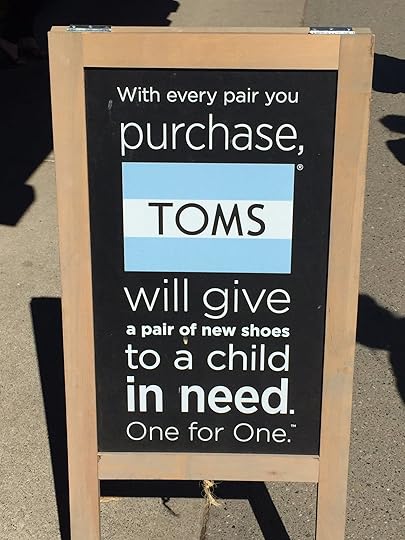
It was the sign you see to the right, parked right in front of Wabi Sabi clothing shop.
If you’re unfamiliar with the story of TOMS, read this fantastic piece by Leigh Buchanan on Inc.
The short version of the TOMS story reads as follows:
“While traveling in Argentina in 2006, TOMS Founder Blake Mycoskie witnessed the hardships faced by children growing up without shoes. Wanting to help, he created TOMS Shoes, a company that would match every pair of shoes purchased with a new pair of shoes for a child in need. One for One®.”
I suppose I was embarrassed, because it was Claire, the 13-year old, who pointed it out to me. “Hey Dad, look at the TOMS sign, isn’t that company so cool?”
Claire knew of TOMS.
I did not.
And here I was, the author of “The Purpose Effect,” a book that profiles many companies who exhibit a higher sense of purpose in their operating ethos, and I was not aware of the TOMS story.
Once we got back to our rented cottage in lovely and picturesque Nanoose Bay, I spent an hour researching the company. Talk about hopeful and inspirational. Wow!
Later that evening, after our dinner and campfire wrapped up, the girls and I watched an incredible documentary titled, Poverty, Inc. Winner of over 50 international film festival honours, the documentary tackles the issue of whether the West and NGO’s in particular are actually helping third-world countries with the vast amount of aid, assistance and financial handouts that have been given out over the years.
In fact, as the documentary argues, unadulterated aid does not help. Ironically, it creates a nation of people waiting for the next handout–a form of paternalism–as opposed to an army of people with the entrepreneurial mindset. TOMS, for example, was highlighted in the film as an organization wanting to do good with its one-for-one shoe program, yet it had created the unintended consequence of helping to create communities used to free shoes.
As I continued my research on TOMS later that night, I discovered it has begun manufacturing shoes in some of the countries and markets where it donates. TOMS answered the bell, now employing more than 500 people in those communities and producing more than 40 percent of the shoes in the communities where they give them away.
The documentary is compelling, but so too was the response by TOMS.
Indeed, the day was another learning experience for me.
It was a day of hope and inspiration.
Dan's Related Posts:In Honour of Ada LovelaceOur Three Young Children Blog … Here’s WhyHierarchy for the Sake of Hierarchy is Simply Being GutlessFive Essential Tips to Effectively Work from HomeAn 8 Year-Old Does Social Learning
August 29, 2016
The Critical Importance Of Defining Your Purpose
Abraham Maslow once wrote, “It isn’t normal to know what we want. It is a rare and difficult psychological achievement,” but I contend team members ought to try to prove Maslow wrong. Aldous Huxley perhaps provided a positive antidote, when he wrote, “Knowing who in fact we are results in Good Being, and Good Being results in the most appropriate kind of good doing.”
It is critically important to know thyself … if one wants to achieve a sense of purpose in life or at work.
 Shutterstock
ShutterstockKelsy Trigg, a leader in the high-tech space, was having dinner with me one night in 2011 when she shared her personal purpose statement. Kelsy highlighted something that night that really made me think.
Do people who exhibit purpose define themselves with some form of personal purpose statement?
In the words of Huxley, does this definition aid “good being and good doing”?
Kelsy’s working life purpose was and continues to be a journey. Whether as an independent contractor or analyst working for banks and insurance companies, or as a leader (director, head, vice-president) in high-tech, she is highly regarded. But the path to purpose came with a few bumps along the way.
Although Kelsy is someone who continuously puts purpose before profit, she had to sort through what gives her true meaning in life and at work. Her giving attitude, thoughtful character and open mind are carefully mixed with operational zest and a high degree of business stratagem. Today she is a consummate and balanced professional that sees her career as a journey of exploration.
Over that dinner, we launched into a discussion about purpose, specifically about one’s personally defined sense of purpose. Kelsy pulls no punches. Her purpose is a testament to her character, and to her self-created definition of how she lives life, both at work and personally. Though it was likely years in the making, when Kelsy put pen to paper, the words came easily and she distilled it into:
I decide to live my life filled with joy.
I decide to be generous, open-hearted, and loving.
I decide to show up whole-heartedly and be present.
I choose courage, integrity, peace and love.
This personal purpose statement has served Kelsy well. Her ability to define who she is and how she will operate—deciding to live and work through the behaviors and attributes outlined above—helped vault her to a level of work that continues to be grounded by her purpose. But Kelsy did not have this clarity until her late 30s. Her prior experiences, roles and organizations helped her to develop enough acumen so that she could reach a point in her life to define what truly mattered.
Indeed, over another dinner in 2015, Kelsy divulged how important the personal purpose statement had become for her.
“For me, the language ‘I decide’ is very powerful, whether it’s deciding how I show up or deciding what my next step in something is. This doesn’t ensure a particular outcome or necessarily impact those around me, but it does provide a sense of grounding and choice about how I respond to my internal and external environment, no matter what my surroundings hold. When I internalized this, it brought a sense of calm for me. My happiness is my responsibility. How I show up is my choice.”
Two points come to mind with respect to Kelsy:
Defining yourself through a personal purpose statement is an important step in the quest for workplace and life purpose.
Individuals should not be afraid to revisit the statement over time to determine if it continues to resonate.
In his seminal 1989 book, The 7 Habits of Highly Effective People, Stephen Covey encouraged people to create a personal mission statement within the second habit, “Begin with the End in Mind.” While it may seem like semantics, I would prefer to call it a “Personal Declaration of Purpose.”
This differs from Covey’s “Personal Mission Statements,” for it is purpose that one is seeking to declare and then establish, not a mission.
The question a successful team member is continuously asking and answering—who indeed is creating a personal sense of purpose—is:
“Who am I in life and at work?”
There is no one right answer, nor should it be viewed as a competitive task against peers and friends. It is an ongoing definition not a one-time commandment. It can occur in your 20s or your 90s or at several points in between.
Philosophers and leaders like Plato, Socrates, Heraclitus or Pythagoras, were alleged to have bandied about the maxim “Know Thyself” in the agora on many an occasion. Self-understanding—knowing oneself—is essential to this. It leads us to surface a critical point.
Personal purpose is the perpetual journey to continually develop, define and decide your what, who and how. When we ask these questions we commit to develop, define and decide our calling, our personal purpose. We pledge to begin knowing thyself.
Constantly redefining who one is in life and at work increases the likelihood that your personal purpose will be realized. Being relentless in the quest for personal purpose is key to achieving the sweet spot. An excellent starting action is to define one’s self through a personal declaration of purpose. It may change over time. That can actually be healthy.
The key point, however, is to take the time to define it and, ultimately, to know thyself.
Just like Kelsy.
PS. Read more in my latest book, The Purpose Effect: Building Meaning in Yourself, Your Role and Your Organization
Download Chapter 1 … for free!
Audible version now available, too. (I’m the narrator!)
Dan's Related Posts:Cool Contest: Win 1 of 10 Free Copies of The Purpose EffectAnd The Winners Of A Free Book Are …The Purpose Effect Launch PartyDownload Chapter 1 of “The Purpose Effect” For FreeEvolution of the Chief Learning Officer
August 22, 2016
My (Re) View Of That Night In Kingston
The room was electric. Abuzz with anticipation. I felt like I was floating. Who put helium in my shoes?
But we were organized. Of course we were. You taught us to be ready. To be born ready. Armed with will and determination.
When I entered the K-Rock Arena on August 20th, 2016 in Kingston, Ontario to witness firsthand what may have been the last-ever performance of the Tragically Hip, for the first time in my life I could smell organized love.
It was everywhere.
 Copyright David Bastedo (MAv)
Copyright David Bastedo (MAv)We were organized.
The Prime Minister walked to the arena. Just like the rest of us.
The countdown began. 30 minutes. 15 minutes. 5 minutes.
A version of O Canada began minutes before the concert started. It wasn’t spontaneous. The CBC didn’t make us do it. It was an organized public service announcement by the 6500 people in the arena. As author and musician Dave Bidini wrote, “Let’s not apologize for who we are, even with the tedium of empty spaces and still-careful ways we announce ourselves on the world’s stage.”
We were announcing our citizenship to the world’s stage. What did we say?
“We are the next us.”
Canadians are the next Canada.
Everyone’s heart in that arena—indeed across Canada—simultaneously morphed into the shape of a maple leaf. We were organized.
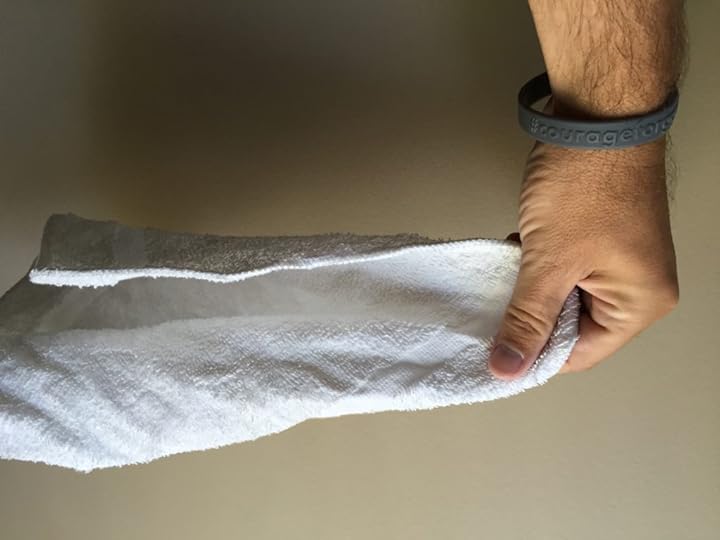 That “handkerchief” of mine.
That “handkerchief” of mine.The Hip strode onto the stage. Go time. Clutching a white handkerchief—like Gord Downie had been using for years, including all fifteen dates of the Man Machine Poem tour—and wearing a black fedora to boot, I made a decision.
Denounce your timidity and announce your love for The Hip on the world’s stage. Embrace it. I got organized. For love.
The band picked up their instruments and launched into Fifty-Mission Cap.
I brought out my white handkerchief and started polishing. At first, it was my chair. As those first few notes swelled I started polishing other chairs around me. I was unleashing my inner Gord Downie pantomime. I was beginning to release 25 years of concert-going love. If this was going to be the last one, after 130 shows—and seven on this tour—I decided to let it all out.
Courage was the next song. My impressionistic Gord Downie dance moves became more feverish. Afforded five feet of space in front of our two floor seats, and an entire five-foot wide aisle right beside me, I decided to forego the apologies. This was not the time for being careful. I was getting even more organized.
Wheat Kings. I thought ahead to the lyrics. “There is an actual Prime Minister in the house, and Gord is going to sing, ‘Hung with pictures of our parents’ prime ministers.’” I polished a few more seats, and slow danced with Denise.
It was then time to step over that big black band of evil. Oh I stepped over it alright. My pantomiming the original pantomimes of Downie became so intense during At The Hundredth Meridian, security came over to ask if I was alright. “You just gotta step right over it,” I said. They had no idea what I was up to. Don’t worry, they got organized soon after.
The second four-pack of songs—as was the case for all 14 previous concerts on this tour—came from the band’s latest album, Man Machine Poem. I wasn’t about to let up. I knew every lyric, too. I said to myself, “Gord probably didn’t have the physical capacity to invent new moves or pantomimes for these songs, so I should.” And I did. My catharsis was in full effect.
Next, during the Music at Work section, the Hip played Toronto #4. It’s a eulogy to Gord’s grandmother. Gord introduced it by saying, “Well Lorna, she really was the best, ya know.” Lorna is Gord’s mother who was in attendance. It hit me hard, like an invisible chop to the sternum.
I got more organized. I made another decision, another unannounced announcement. Anyone who walked by me, whether in front or to my side, would get either a high five or a hug. It was the right thing to do. My love had to be released. Gord gave a shout-out to his mom. I was going to reciprocate somehow.
And so, for the rest of the show, my pantomiming got out of control, my dancing was ever-so-Gord-esque, my high-fives and hugs increased, and my polishing took on epic proportions.
I headed out into the crowd, down our row, into other rows, up the stairs, and along the side of the stands. I began to polish rings, watches, VIP passes, whatever I could find. People would see me coming, and they’d hold something out to be polished. Others just wanted a hug. Men kissed me on the cheek many times. A few found my lips.
The love was becoming unbridled. It was cathartic.
We had all become organized. With will and determination.
And then came the song, Blow at High Dough. Something took over me. Something took over us. All of us. I witnessed 6500 people transform into a singular organism. One of love, for love. With much love. Enlightenment and Nirvana were now upon us, a path any Buddhist monk would recognize.
“It’s been a pleasure doing business with you,” sang Gord during Scared. My handkerchief was no longer being used to polish things. It had become a tear-soaked crutch. My pantomiming ceased. My hugs and high-fives ended. And then the band launched into Grace, Too. I knew the end was near.
I had just finished writing about Gord’s resilience and grit in a post called, “Him? Here? Now? No.” But there I was, watching a man 52-years young, screaming those exact words into a microphone. It was merciless. He was crying. I was crying. We were all crying. I wanted to give him my handkerchief to soak up his tears. I wanted to give him one of my hugs.
But I couldn’t, of course. You know why?
It was Gord’s public announcement. Mic drop. There would be no apologies. For he is an artist, and an artist produces art.
His tears were for the love of his art.
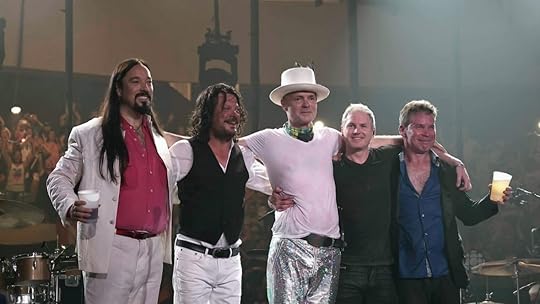 Copyright CBC
Copyright CBCAnd Gord Downie has always been organized. He has always been an artist.
The band came together one last time after Ahead by a Century, arms hung over one another in a singular row of five, to say a final goodbye. They were organized. They always have been. They are artists. They always will be.
The helium left my shoes. But then I quickly remembered.
We are the next us.
Please Donate
Please consider donating to the:
Gord Downie Fund for Brain Cancer Research
Dan's Related Posts:Gord Downie and the New Marathon of HopeThat Time I Was Ambushed By Gord DownieHow I Learned To Think Out Loud Through The Tragically Hip’s Live ConcertsHim? Here? Now? No.Why I’m Currently Only Writing About Gord and the Hip
August 19, 2016
Him? Here? Now? No.
I don’t want to die.
As far as I know, thankfully, I’m not dying.
But if we’re being honest with one another, I am not all that comfortable thinking about my death. Imminent or otherwise.
But the fact of the matter is whether sudden or prolonged, we are all dancing our own path to the waterfall.
I love my life. I love what it was. I love what it has become. I love what it is.
I also love thinking about what is to come.
What’s the next ocean to cross? What’s the next prose to read? What’s the next nuance to discover? What’s the next shadow to outwit?
There are many questions I like to ask.
Disentangling tomorrow is what I do.
It’s what I’ve always done.
I love today. I love each day.
But I am also hardwired to think about the day after today. Tomorrow is not just another day. It is the day of infinite possibility. Of perpetual positivism. What’s wrong can be righted. What’s problematic can be solved. What’s missing can be found. What’s learned can be unlearned.
Ultimately, today is thinking fodder for tomorrow. And I love tomorrow.
But if I know that my tomorrows are time limited, how should I act? Interact? React?
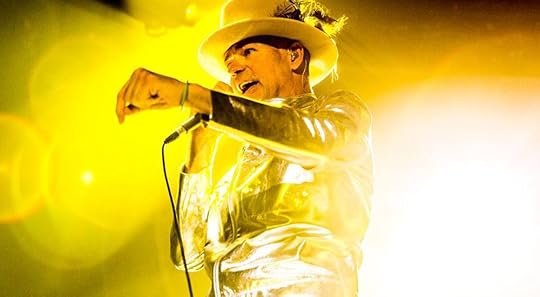 Copyright David Bastedo
Copyright David BastedoWhat’s the plan, man?
Him? Here? Now?
No.
This is what you have taught me.
It’s the lesson of the grand bounce.
We need not be scared of death. If it is thrust upon me, like you, I will use the unfolding scenario as the opportunity to help define tomorrow for someone else. Perhaps for many. The Big Apple clock need not unceremoniously hurtle towards the ground and shatter to pieces.
Whilst my tomorrow may physically cease one day, it will continue for others. My three children. Better half. Family. Friends. Loyal readers. Maybe there are more.
How I hold my head today—despite the inevitability of tomorrow—will be how I am remembered. To act in any less a manner would be selfish. Frankly it would be wrong.
I have watched, listened and embraced you and your band from afar for a quarter of a century. How’d it get this late so early? But the past 30 days has nothing on that period. Some say it’s courage. Of course it’s courageous.
But it’s more than courage.
I have come to realize you are defining your tomorrow, today.
This is what I have learned.
Whether for your family, band mates, friends or fans, you have indeed become “involved in a life that passes understanding,” imploring each of us to remember that “our highest business is our daily life.” God I love John Cage.
Your tomorrow has become your today. It’s your highest business.
And if dark prematurely rings the door for me one day with a customized forewarning, I will do whatever I can to embrace tomorrow, today.
Like you.
That’s right, let’s just see what tomorrow brings.
Today.
If him is death, now is in fact never.
Him? Here? Now?
No.
Never.
Thank you Gord. For today.
Please Donate
Please consider donating to the:
Gord Downie Fund for Brain Cancer Research
Dan's Related Posts:“The Inevitability of Death”Gord Downie and the New Marathon of HopeWhy I’m Currently Only Writing About Gord and the HipCanada’s Poet Laureate, Gord DownieThat Time I Was Ambushed By Gord Downie
August 17, 2016
Gord Downie May Be The Best High School Teacher I Never Had
It’s been some time since I patrolled the jaundice-colored halls of my high school. Those were awkward days.
Acne, Bunsen burner fiascos and infamous air band “talent shows” were iffy memories for me. With all due respect to Mr. Baxter and any other teacher of Saltfleet High School in Stoney Creek, Ontario, I think Gord Downie is (and was) a far better educator.
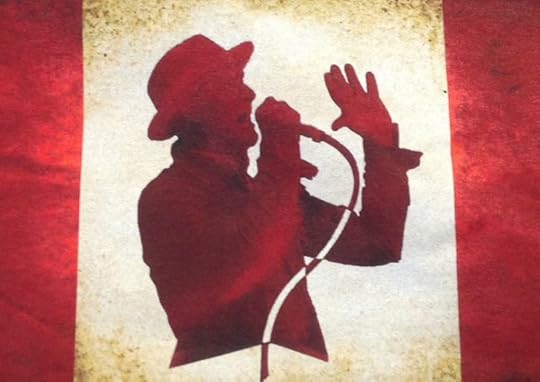 As the lead singer and lyricist of the Tragically Hip, Downie has been writing the band’s lyrics since the late 1980’s. If you look back at the 200+ songs (and poems) attributed to him, a trend begins to slyly appear.
As the lead singer and lyricist of the Tragically Hip, Downie has been writing the band’s lyrics since the late 1980’s. If you look back at the 200+ songs (and poems) attributed to him, a trend begins to slyly appear.
Downie just might be Canada’s best high school teacher. And I mean ever.
What subjects you ask? Geography, History and English.
Geography Teacher Downie
The obviousness of being an excellent geography teacher is by virtue of the scores of cities Downie inserts into the lyrics. Close to forty times in fact.
There are the unmissable and known ones—Toronto, New York, Vancouver and Chicago—but it’s those obscure towns and hamlets he mentions that force you to Google Maps. If you’re old, like me, heaven forbid you may use an actual atlas.
Regardless, this is where the teaching begins.
Gambier Islands, Mistaken Point, Moonbeam, Chagrin Falls, Isle aux Morts, Golden, Thompson and Cape Spear are not well-known places. You could pass through them in a car (or canoe in some cases) and never know you had set foot in its city limits. But for me, when they surfaced in a Tragically Hip song, it would send me running for a map. I just had to know where Gord was taking me. No high school teacher ever did that for me.
The best known geography lesson is arguably Bobcaygeon, “where I saw the constellations, one star at a time,” as Downie once wrote. It’s a tune that came from a 1998 Hip album that sent the small hamlet of 3,500 inhabitants of this quaint, cottage country Ontario town into a geographic song lottery frenzy. There’s even a wonderful documentary by Andy Keen called—you guessed it—Bobcaygeon.
The most touching geography lesson is potentially a history lesson as well. We should just call Downie a social studies teacher and give him free coffee in the staff room for the rest of his teaching career. Goodnight Attawapiskat—a song that introduces an First Nation town in northern Canada that has endured devastating social and economic hardship—is an ode to both the map and one’s heart. Indeed, no one wants to sing a song that they don’t love, as the tune suggests.
History Teacher Downie
Given Downie recently received an honorary doctorate from Queen’s University, we can now refer to him as Dr. Downie. It’s appropriate for high school teachers, like our man Downie, who also write songs laced with historical twists and implants that have you searching Wikipedia (or real books) until you have finally solved (albeit exhausted) the reference he has slotted into a chorus or verse.
Daredevils plunging over Niagara Falls? Check. Painter Tom Thomson and his bride Winnie Trainor in Algonquin Park? You bet. Europeans, like Jacques Cartier, ruthlessly taking over the lands of First Nation people? It happened. What about 19th century cholera outbreaks across the Great Lakes? A feverish story. Artist Bill Reid and his Spirit of Haida Gwaii sculpture? But of course. John Cage? Downie’s history lessons are in fact laden with Cage references, and influences.
Professor Downie has always used his lyrics to imaginatively teach various components of Canada’s and indeed the world’s. The problem? You often need Alan Turing-like cryptology skills to unearth many of the hidden historical gems. But when you do, it’s better than whatever you were taught in grade 12 history class. (With apologies to Mr. Hay, my actual history teacher.)
English Teacher Downie
But where I think Downie has excelled the most over his writing career is as a high school teacher of English.
Sure there are the poems. There are the mellifluous sonnets. Downie even cleverly utilized a poem by Wallace Stevens titled, Sea Surface Full of Clouds as the entire basis for the structure of the song, Dire Wolf.
But that’s not why he’s my favorite English teacher. Downie has found a way to weave words into the lyrics that should have Oxford bestowing him an honorary degree, too. I don’t know of another rock band lyricist who can so effortlessly insert underused and unappreciated words into songs while simultaneously sending thousands of fans in search of a dictionary. Here is a small sample of words found in Tragically Hip songs:
Aesthetes
Autodidact
Avocet
Peregrine
Desultory
These are not everyday words, per se, yet Downie forces you to learn English while enjoying a tune at the same time.
In short, one must refrain from perfunctorily reading Downie’s lyrics otherwise you will miss the chance to potentially sound grandiloquent or magniloquent. (See what I did there?)
In Summary
I know. Gord Downie is not a high school teacher. But imagine if he was.
Picture him at the front of the class, reciting Shakespeare, or pantomiming European explorers paddling down a river, or inserting new words into a lecture.
That’s the kind of high school teacher I’d be into. That’s the kind of poet I will (eventually) miss.
Post Script. If you’re interested, the Canadian Broadcasting Corporation created an incredibly interactive site that maps many Canadian cities and villages referenced by Downie.
Originally published to The Huffington Post.
Please Donate
Please consider donating to the:
Gord Downie Fund for Brain Cancer Research
Dan's Related Posts:That Time I Was Ambushed By Gord DownieGord Downie and the New Marathon of HopeHow I Learned To Think Out Loud Through The Tragically Hip’s Live ConcertsWhy I’m Currently Only Writing About Gord and the HipCanada’s Poet Laureate, Gord Downie
August 10, 2016
“It’s a great time to be an artist, a poet, in this the decline of the human empire.”
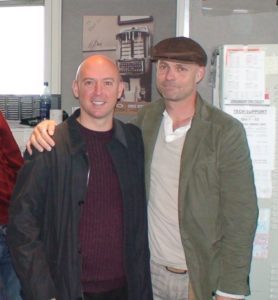 More audio from my conversation with Gord Downie in 2006.
More audio from my conversation with Gord Downie in 2006.
This clip is from the onset of the interview, where we discuss Vancouver, animal rights and the environment.
It was the beginning of something special … “something on.”
http://www.danpontefract.com/wp-content/uploads/2016/08/GordDan_intro.mp3
Please consider donating to the:
Gord Downie Fund for Brain Cancer Research
Dan's Related Posts:Why I’m Currently Only Writing About Gord and the HipThat Time I Was Ambushed By Gord DownieGord Downie and the New Marathon of HopeCanada’s Poet Laureate, Gord DownieHow I Learned To Think Out Loud Through The Tragically Hip’s Live Concerts
August 9, 2016
Why I’m Currently Only Writing About Gord and the Hip
 I’ve yet to lose a close, blood-related family member.
I’ve yet to lose a close, blood-related family member.
I don’t know what it feels like to suddenly be deprived of a child, a sibling, a parent. A life partner.
When news broke in late May of Gord Downie’s terminal brain cancer diagnosis, hearts broke everywhere. A friend was unexpectedly being taken away too early. Our friend. Like for many, it deeply hurt. It’s precisely when the hornet stung me.
But then my mind began to wander. Maybe the stinger was a wakeup call. I began to think of my friend Bryan, who lost his father to a similar form of cancer just a few years ago. Bryan has been raising money for cancer research in various ways ever since. He does so to honour his dad.
My wife works with someone who lost her husband to the exact form of cancer that has overcome Downie. She no longer has a husband. Her two very young children no longer have a father. It was heartbreaking to watch what that family had to endure.
I am still a husband and a dad and a brother and a son. My parents are otherwise healthy, as are my siblings and children. Denise is healthy and as lovely as ever.
I have not suffered any direct loss.
For Bryan, Denise’s colleague … for Downie, I decided to do something I have never done before.
I decided to devote thirty days of writing and social media entries to raising awareness of Glioblastoma. It’s the form of brain cancer Downie and others have been afflicted with.
I’m healthy, and everyone around me is too. But that is unusual. A little super dangerous, perhaps.
And so, on August 9, 2016, I sit here in the back country of Thornbury, Ontario on holiday grateful for my plight but compassionately mindful of those mired with loss, pending or otherwise.
I am but one man holding his own 400 pound feather, but it really is the least I could do. At least until August 20.
Please consider donating to the:
Gord Downie Fund for Brain Cancer Research
Dan's Related Posts:Gord Downie and the New Marathon of HopeThat Time I Was Ambushed By Gord DownieCanada’s Poet Laureate, Gord DownieTerry Fox, My HeroHow I Learned To Think Out Loud Through The Tragically Hip’s Live Concerts

